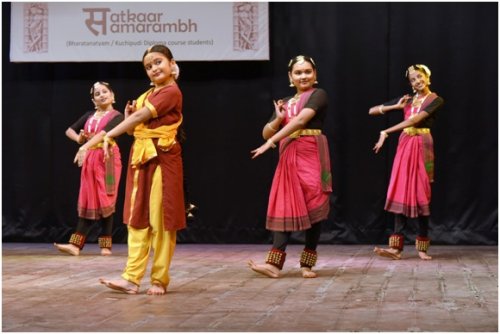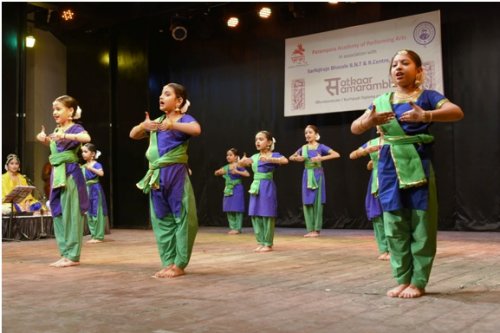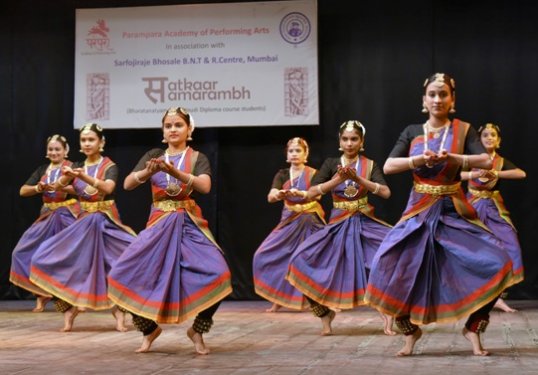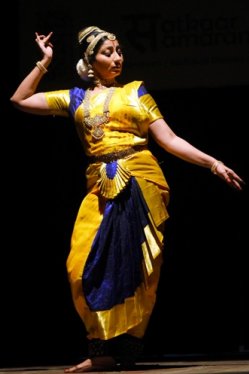
|   |

|   |
A steadfast pursuit of dance studies according to parampara - Dr. S. D. Desai e-mail: sureshmrudula@gmail.com November 5, 2019 Art has oceanic depths. In the age of shortcuts to spectacular success, it is gladdening to see a relatively young dancer and the centre she runs desiring with the guidance of a knowledgeable guru, who has her field of activity in another city, to plunge and explore the depths. To continue with the image, currently she can be said to be only splashing the water at the shore. With the personal preparedness she is building up, however, she holds a promise for the future when she could make a significant contribution to dance studies and practice in Gujarat. Bharatanatyam and Kuchipudi dancer Bijal Haria's Parampara Academy of Performing Arts, which was launched by Raja-Radha Reddy in 2009, held a significant two-part event on October 20. In the morning was Bharatiya Natyashastra Sangoshthi, where Dr. Mahesh Champaklal from Vadodara gave a scholarly Keynote Address on Bharata's Natyashastra, limiting himself to its first chapter, with Dr. Sunil Kothari in the chair. A few others, including Dr. Gautam Patel, an eminent Sanskrit scholar, Madhavi Puranam, Chief Editor, 'Nartanam', and Bhavana Dave, Vice-Chairperson, University Granth Nirman Board, Gujarat, joined the symposium. The occasion was to welcome publication of Part One of the treatise insightfully translated into Gujarati by Dr. Sandhya Purecha. A senior disciple of the late Acharya Parvatikumar, researcher-dancer-choreographer Dr. Purecha has given an audio-visual form to Nandikeshwara's full Abhinayadarpanam (324 shlokas) under his guidance with her solo Bharatanatyam performances for IGNCA, New Delhi. Her doctoral thesis is on Natyashastra - its theory and practice with reference to the Bharatanatyam angika abhinaya. A consensus emerged at the symposium that Bharatamuni Virachitam Natyashastram, a fine book production with sandhi-vigraha, anvaya and a translation of each shloka in simple Gujarati, is an invaluable reference book and all dance centres should have a copy of it on their shelf for their students to refer to it from time to time. So far, everyone including teachers and gurus swear by Natyashastra and few have studied it. The major deterrent has been its language - Sanskrit. The Satkaar Samarambh in the evening (HK Auditorium) was primarily designed to felicitate Parampara students upon their steadfast pursuit of dance studies at various stages of the Diploma Course of Sarfojiraje Bhosale BNT & R Centre (Mumbai). All these students and their dance teacher participated in the felicitations. In the process, it got demonstrated that following the age-old tradition modestly at dance teaching centres is not all that difficult - provided you know it from authentic sources. The participants followed Natyashastra, Sangeeta Ratnavali and Abhinaydarpanam.  Kuchipudi  Namaskriya It was exhilarating to see, for example, First Year students (6 years of age and above) of the course cheerfully and with understanding reciting various Sanskrit shlokas demonstrating the use of hands, feet and eyes in Bharatanatyam, and explaining the basics of Talam. Every one of the thirty kids presented in two clusters right up to the last row looked comfortable and cheerful in what they were doing. In Kuchipudi, which is introduced this year, the kids showed basic adavus. Progressively in Bharatanatyam, while learners at the intermediate level did Pushpanjali (Brahmapeethasyamadhye tu swayam Brahma pratishitam), those at the advanced level did Panchakshari (Tasmai Namah Shiva...) with a pleasing ease the same way. Bijal, the teacher, who had her initial training under Smita Shastri at Nartan, has been under the tutelage of Dr. Purecha (Mumbai) for Bharatanatyam for fifteen years and of Raja Reddy (Delhi) for Kuchipudi for ten years. With the Government of India's Junior Fellowship (2014-16), she translated and did a comparative study of Jayasenapati's Nritta Ratnavali. She is now waiting for a nod from Kavi Kulaguru Kalidas Sanskrit University (Nagpur) to begin working on her Ph.D. based on the work. These continuing pursuits reflect in her evolving dance performance and in her teaching at Parampara. The culmination at the evening performances was in Bijal's lyrically nuanced Kuchipudi performance portraying, as in a narrative, a pensive sculpted goddess in a temple, beautiful but in a frozen state. She longs to be part of the human life beautifully in motion to the sweet flow of earthly music. The rhythmic thuds on the soil accompanied by tinkling bells become the metaphor of the enchanting human life on earth. She melts into an alluring human form and dances to her utmost delight. Sadly however she has to return to her sculpted form. Particles of sand pull at her heels - like the deer pulling at Shakuntala's valkal - urging her not to leave! Much against her wish, she returns to her frozen state. In Raja Reddy's informed choreography, the Kuchipudi dancer gives a dainty performance that remains in the viewer's memory with a cherished angavinyas, angabhangi and graceful movement.  Pushpanjali  Temple goddess Musically anchoring the performances, becoming their integral part, were accomplished musicians Jayan Nair (vocal), Palanivelu (mridangam), Prem Kiran Menon (violin) along with emerging teenage percussion ustad Manav Nair on the ghatam. Bijal Haria sat with nattuvangam for the students. Dr. S.D. Desai, a professor of English, has been a Performing Arts Critic for many years. Among the dance journals he has contributed to are Narthaki, Sruti, Nartanam and Attendance. His books have been published by Gujarat Sahitya Academy, Oxford University Press and Rupa. After 30 years with a national English daily, he is now a freelance art writer. |